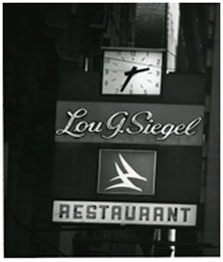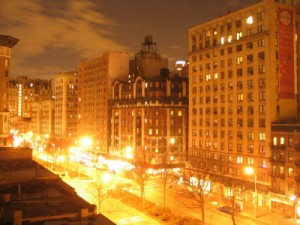January 24th, 2014 § § permalink
Two events, one tragic and one sad, took place in New York City some 18 years ago. For HG, these events marked the end of New York’s Jewish ambience. Sure, the New York of that time, like today, had multitudes of Italians, Irish, African-Americans, Asians, and Hispanics. But, it was the Jews who set the overall tone of the city. The tragic event took place on March 5, 1996. On that day, Abe Lebewohl, the proprietor of the original Second Avenue Delicatessen (2nd Avenue and 10th Street), was shot and killed as he delivered cash receipts to a nearby bank. Lebewohl not only ran a great Jewish delicatessen, he was also a direct link to Second Avenue’s colorful past as the home of Yiddish theater. And, he honored that past by naming one of the delicatessen’s dining rooms after Molly Picon, a Yiddish musical star (and a favorite of HG’s Mom). Wonderful Jewish delicatessens like Gitlitz (79th and Broadway) are gone. Katz’s remains on the Lower East Side — a stalwart in these lean deli times where the venerable Carnegie Deli has devolved into a grotesque tourist trap known only for the over-stuffed size of their sandwiches.
The sad event was the closing of Lou G. Siegel’s on June 29, 1996. It had been in business for 79 years. Lou G. Siegel was a distinguished and dignified restaurant in the heart of New York’s Garment Center (38th Street just west of Seventh Avenue). It was strictly kosher (there were two Rabbis on the payroll) and the food was delicious, hearty and caloric. It was where observant Jewish (were there any other?) clothing executives dined. The non-observant big shot Jews ate at Al Cooper’s, further east on 38th. The garment workers frequented Dubrow’s and the other very good cafeterias in the vicinity. They are all gone. Seventh Avenue has been named “Fashion Avenue”. The Garment Center with its rabid union members, gangsters and famed lunchtime schmooze is now the Fashion District. The habitues of Siegel’s kingdom of chicken fat and rugelach would have a sardonic laugh. Siegel’s was the best of a host of traditional kosher restaurants that served meat ( Kosher law, “kashriuth”, forbids the mingling of meat and dairy products). Some of the other restaurants of that type were Moskowitz & Lupowitz and Gluckstern’s. Sammy’s Romanian (Allen and Delancey) is a survivor. The food (non-kosher) is tasty. The prices are steep. The atmosphere is a Jewish parody, a broad dialect joke. The great, strictly dairy (and fish) Jewish restaurants (Ratner’s, Rappaport’s, Steinberg’s, Paradise) are gone although some smaller operations still exist. This is not to say that there aren’t kosher restaurants left in New York — There are plenty of them spread throughout the five boroughs, catering to a new generation of the observant and a new group of Israeli and Russian Jewish immigrants. The menus would be un-recognizable to the observant Jews of fifty years ago as they feature kosher sushi, kosher Italian and kosher Indian food (amongst others). The restaurants HG misses most are those that were not kosher and had wide ranging menus that included, but were not confined to, Eastern European Jewish food. The three greatest, of course, were Lindy’s, Reuben’s and Tip Toe Inn. Gone. New York has, for better or worse, lost much of its Jewish flavor. It is now a truly international city with a cuisine to match. No, New York is no longer Jewish but it if you are hungry it’s a great town.

December 19th, 2013 § § permalink
Al Goldstein, the eccentric publisher of Screw magazine and pioneer of hard core, “non socially redeeming” porn is dead. At one point in his very checkered career (according to the Times obit) he was a “greeter” at the 2nd Avenue Delicatessen in New York. Only met Al once (when he was a deranged teenager) but his father, Sammy, was a pal. Sammy, a news photographer at International News Photos, loved to eat. (so did Al, who once weighed 350 pounds). When HG was a photo editor at INP, HG and Sammy (a pastrami addict), shared many meals at the 2nd Avenue Deli and Katz’s. (The duo also overate at Ratner’s, Sammy’s, Dubiner’s,Rappaport’s and other Lower East Side eateries). Sammy was a very good boxing photographer. HG has a vivid memory of Sammy at Madison Square Garden (then on 8th Avenue) ringside putting down his Speed Graphic between rounds to munch on (you guessed it) a pastrami on rye.

April 17th, 2013 § § permalink
Good news. A health magazine recently reported that pork rinds are a (relatively) healthy food. Yes, plenty of fat in these bits of fried pork skins but its a good kind of fat and the skins contain plenty of beneficial oelic acid. Since HG likes to scatter some pork rinds over a bowl of green chili stew the happy report caused HG to muse over other (not so healthy) fried favorites. When HG used to visit the streets of the Washington Heights section of Manhattan (lots of Puerto Ricans, Dominicans and Cubans lived there) HG would often drop into one of the plain spoken restaurants for a favorite meal: Moros y Cristianos ( Moors and Christians–black beans and rice topped with chopped raw onions) and a bowl of Chicharrones (fried pork fat, a by product of lard production). When in a hurry, HG would buy a snack at a Cuchifrito. A Cuchifrito is a colorfully decorated rolling cart that sells freshly made fried foods. (“Cuchifrito” also refers to a whole range of fried pork dishes served in Puerto Rican restaurants). HG remembers with fondness the baccalitos (salt cod pancakes) and rellenos de papas (fried mashed potato balls stuffed with meat or cheese) dispensed by a little cart near St. Nicholas Avenue. However, when HG explores the fried food HG memory bank, the taste standout is old fashioned fried chicken skin (fried in chicken fat, of course) that HG’s Mom cooked while she was rendering schmaltz (chicken fat). A favorite HG childhood sandwich was two slices of Pechter’s Pumpernickel Bread enhanced with an abundance of chicken fat, fried onions and a load of fried chicken skin (gribenes.) Serve a youngster that dish today and it’s off to jail you’ll go for impairing the health of a minor. HG has learned that the Second Avenue Delicatessen in New York (the new one in the East 30’s–the revered old one on Second Avenue closed following a rent dispute) serves a free “amuse bouche” of gribenes. Must indulge on next New York visit.

October 10th, 2012 § § permalink
Some 48 years ago (seems like yesterday). HG, BSK, their two adorable children, their live-in mother’s helper and their poorly trained but decorative standard poodle, lived in a 12th floor Upper West Side apartment with dramatic views of the Hudson River and the New Jersey Palisades. A very spacious residence. Big living room. Big, separate dining room. Nice windowed kitchen and pantry. Four bedrooms and three baths (one en suite). The rent: $274 a month (later raised to $292 and a similar apartment in the same building now rents for $15,000 a month). Ah, rent control, you lovely bit of legislation (of course, obtaining this rent controlled paradise involved some bribery, chicanery and corruption). This did not shock HG, a born and bred New Yorker. In those days the Upper West Side was affordable and diverse. There was still a heavy Jewish influence. Big time theater and entertainment folks (Abe Burrows, Leonard Bernstein, Isaac Stern and many more) lived on Central Park West alongside many affluent professionals and business persons. Side streets from Central Park West to Broadway were gritty (except for W. 67th Street, site of the Des Artistes apartment house and many studios of painters and musicians). Riverside Drive and the Avenues and cross streets west of Broadway were filled with intellectuals and creative types who had more brains and talent than money. Forget Greenwich Village. The Upper West Side was the home of professors, critics, novelists, dancers, journalists, composers, actors, musicians and school teachers. Lots of European intellectuals who had fled Hitler and many Holocaust survivors (the little, pale, Nobel Prize winning writer, Isaac Baashevis Singer, who lived on W. 86th Street, often wrote about them). The Heresford (West Side apartment houses often had British names, a touch of Anglophile class) where HG and BSK lived, had much artistic ferment. Among its residents were Peter Boyle (before Hollywood and TV fame); film composer Michael Small, the critic and editor Ted Solotaroff; Gary Null, the health and sex writer, guru and radio personality. There were also some Broadway dancers, the cantor of a major synagogue and lesser artistic lights. The Upper West Side was filled with movie theaters showing art films (the New Yorker, Thalia and Symphony) and plus the first run houses (Loew’s 83rd, the Beacon,etc.). Food was a neighborhood obsession. Zabar’s, of course, but also Murray’s (preferred by some smoked fish aficionados) and Barney Greengrass (unsurpassed sturgeon). Middle European restaurants like Eclair and dairy restaurants like Steinberg’s and Paramount. Gitlitz’ Delicatessen on Broadway and 78th ( much superior in HG’s informed opinion, to Katz’s, Carnegie or 2nd Avenue Deli). The jewel of the West Side was the Tip Toe Inn (on Broadway near 86th Street). A huge place with a huge menu. Everything was delicious and inexpensive (the New York Public Library has a nice collection of old menus….Here’s a link to Tip Toe’s 1954 menu. Be astonished). There was a rotisserie in the Bretton Woods Hotel (86th and Broadway) that barbecued ducks and chickens. Sunday dinners for HG and BSK often featured one of those juicy, crisp skinned ducks and an avocado-sweet onion-sliced orange salad. Chinese restaurants were clustered around Broadway and 96th and they were very good (the first Szechuan restaurant in New York was on Broadway and 95th). There were also some Cuban/Chinese places where you could get good shrimp dishes plus Moros y Cristianos (black beans and rice) Fairway didn’t exist but for those who liked to eat at home there were butchers like Endicottt Meats and Nevada Market (where you could get some exotic stuff including bear, in season). Good bakeries. Mom and Pop greengrocers. Citarella’s for fish. Broadway Nut Shop for sweets. Daitch Dairy (79th and Broadway) for tub butter and cheese. Bretton Wood Rotisserie for barbecued ducks. HG and BSK were not plutocrats but could afford all of these good things. Yes, the Upper West Side had lots of junkies, hookers, muggers and burglars. Their presence made West Siders feel superior to residents of the antiseptic Upper East Side. Now, let HG make you young folks really jealous. HG, BSK and family spent all summer plus spring and fall weekends at their Fire Island home. Built atop a dune it had panoramic views of the Atlantic Ocean and Great South Bay sunsets. The family bought it for $40.000. HG’s first Fire Island house (in 1959) cost $4,000 ($1,000 for land and $3,000 for two bedrooms, bathroom, kitchen, living room and deck). In 1960, HG added two more bedrooms, another bathroom and additional decking. Cost: $2,000. That’s right. The numbers for these Fire Island properties are correct. Read and weep.




